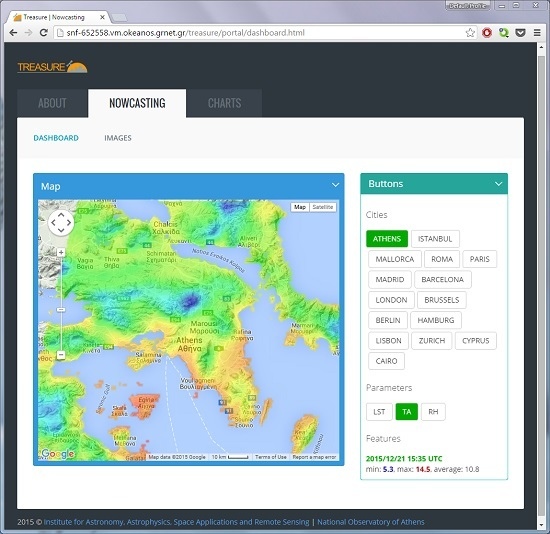An Online System for Nowcasting Satellite Derived Temperatures for Urban Areas
Abstract
:1. Introduction
2. The EO-Based System Developed by IAASARS/NOA
2.1. Data Employed in the IAASARS/NOA TA System
2.1.1. SEVIRI Data
2.1.2. GFS
2.1.3. Digital Elevation Model
2.2. TA Estimation Algorithm
2.3. IAASARS/NOA Web Service
2.3.1. Nowcasting Dashboard
2.3.2. Charts
3. Results of September 2015 Evaluation
3.1. In Situ TA Observations
3.2. Aggregated Results
3.3. Diurnal Variation of Accuracy
3.4. Diurnal Variation of Accuracy According to Different Location Classifications
4. Discussion
5. Conclusions
Acknowledgments
Author Contributions
Conflicts of Interest
Abbreviations
| ASTER | Advanced Spaceborne Thermal Emission and Reflection Radiometer |
| AVHRR | Advanced Very High Resolution Radiometer |
| BT | Brightness Temperature |
| CMa | Cloud Mask |
| DEM | Digital Elevation Model |
| DLST | Downscaled Land Surface Temperature |
| EUMETSAT | European Organization for the Exploitation of Meteorological Satellites |
| FOR | Field-of-Regard |
| GFS | Global Forecasting System |
| GRIB | Gridded Binary |
| HRV | High Resolution Visible |
| IAASARS/NOA | Institute for Astronomy, Astrophysics, Space Applications and Remote Sensing of the National Observatory of Athens |
| LST | Land Surface Temperature |
| MAD | Mean Absolute Difference |
| MODIS | Moderate Resolution Imaging Spectroradiometer |
| MSG-SEVIRI | Meteosat Second Generation—Spinning Enhanced Visible and Infrared Imager |
| NCEP | National Centers for Environmental Prediction |
| NDVI | Normalized Difference Vegetation Index |
| NOAA | National Oceanic and Atmospheric Administration |
| NWP | Numerical Weather Predictions |
| Rho | Pearson’s Correlation Coefficient |
| RMSE | Root Mean Square Error |
| RSS | Rapid Scan System |
| RT | Radiative Transfer |
| RTTOV | Radiative Transfer for TIROS (Television Infrared Observation Satellite) Operational Vertical Sounder |
| SAFNWC | Satellite Application Facility for Nowcasting Weather Conditions Software |
| SPhR | SAFNWC’s Physical Retrieval Algorithm |
| SRTM | Shuttle Radar Topography Mission |
| SZA | Solar Zenith Angle |
| TA | Air Temperature at 2 m Height |
| TIR | Thermal Infrared Radiation |
| TVX | Temperature-Vegetation Index |
| UHI | Urban Heat Island |
| UTC | Coordinated Universal Time |
References
- United Nations. World Urbanization Prospects: The 2014 Revision, Highlights (ST/ESA/SER.A/352); United Nations: New York, NY, USA, 2014. [Google Scholar]
- Schneider, A.; Friedl, M.A.; Potere, D. Mapping Global Urban Areas Using MODIS 500-M Data: New Methods and Datasets Based on “urban Ecoregions”. Remote Sens. Environ. 2010, 114, 1733–1746. [Google Scholar] [CrossRef]
- Oke, T. The Energetic Basis of the Urban Heat Island. Q. J. R. Meteorol. Soc. 1982, 108, 1–24. [Google Scholar] [CrossRef]
- Akbari, H.; Davis, S.; Dorsano, S.; Huang, J.; Winnett, S. Cooling Our Communities a Guidebook on Tree Planting and Light-Colored Surfacing; EPA: Washington, DC, USA, 1992. [Google Scholar]
- Rizwan, A.M.; Dennis, L.Y.C.; Liu, C. A Review on the Generation, Determination and Mitigation of Urban Heat Island. J. Environ. Sci. 2008, 20, 120–128. [Google Scholar] [CrossRef]
- Ding, B.; Rosenfeld, A.H.; Akbari, H.; Bretz, S.; Fishman, B.L.; Kurn, D.M.; Sailor, D.; Taha, H. Mitigation of Urban Heat Islands: Materials, Utility Programs, Updates. Energy Build. 1995, 22, 255–265. [Google Scholar]
- Tan, J.; Zheng, Y.; Tang, X.; Guo, C.; Li, L.; Song, G.; Zhen, X.; Yuan, D.; Kalkstein, A.J.; Li, F. The Urban Heat Island and Its Impact on Heat Waves and Human Health in Shanghai. Int. J. Biometeorol. 2010, 54, 75–84. [Google Scholar] [CrossRef] [PubMed]
- Lo, C.P.; Quattrochi, D.A. Land-Use and Land-Cover Change, Urban Heat Island Phenomenon, and Health Implications: A Remote Sensing Approach. Photogramm. Eng. Remote Sens. 2003, 69, 1053–1063. [Google Scholar] [CrossRef]
- Kolokotroni, M.; Ren, X.; Davies, M.; Mavrogianni, A. London’s Urban Heat Island: Impact on Current and Future Energy Consumption in Office Buildings. Energy Build. 2012, 47, 302–311. [Google Scholar] [CrossRef]
- Basu, R. High Ambient Temperature and Mortality: A Review of Epidemiologic Studies from 2001 to 2008. Environ. Heal. 2009, 8, 40. [Google Scholar] [CrossRef] [PubMed]
- Ho, H.C.; Knudby, A.; Xu, Y.; Hodul, M.; Aminipouri, M. A Comparison of Urban Heat Islands Mapped Using Skin Temperature, Air Temperature, and Apparent Temperature (Humidex), for the Greater Vancouver Area. Sci. Total Environ. 2015, 544, 929–938. [Google Scholar] [CrossRef] [PubMed]
- Ho, H.; Knudby, A.; Huang, W. A Spatial Framework to Map Heat Health Risks at Multiple Scales. Int. J. Environ. Res. Public Health 2015, 12, 16110–16123. [Google Scholar] [CrossRef] [PubMed]
- Kloog, I.; Melly, S.J.; Coull, B.A.; Nordio, F.; Schwartz, J.D. Satellite-Based Spatiotemporal Resolved Air Temperature Exposure to Study the Association between Ambient Air Temperature and Birth Outcomes in Massachusetts. Environ. Health Perspect. 2015, 123, 1053–1058. [Google Scholar] [CrossRef] [PubMed]
- Kovats, R.S.; Hajat, S. Heat Stress and Public Health: A Critical Review. Annu. Rev. Public Health 2008, 29, 41–55. [Google Scholar] [CrossRef] [PubMed]
- Lai, P.-C.; Choi, C.C.Y.; Wong, P.P.Y.; Thach, T.-Q.; Wong, M.S.; Cheng, W.; Krämer, A.; Wong, C.-M. Spatial Analytical Methods for Deriving a Historical Map of Physiological Equivalent Temperature of Hong Kong. Build. Environ. 2016, 99, 22–28. [Google Scholar] [CrossRef]
- Shi, L.; Kloog, I.; Zanobetti, A.; Liu, P.; Schwartz, J.D. Impacts of Temperature and Its Variability on Mortality in New England. Nat. Clim. Chang. 2015, 5, 1–5. [Google Scholar] [CrossRef] [PubMed]
- Bechtel, B.; Zakšek, K.; Hoshyaripour, G. Downscaling Land Surface Temperature in an Urban Area: A Case Study for Hamburg, Germany. Remote Sens. 2012, 4, 3184–3200. [Google Scholar] [CrossRef]
- Nichol, J.E.; Wong, M.S. Spatial Variability of Air Temperature and Appropriate Resolution for Satellite-Derived Air Temperature Estimation. Int. J. Remote Sens. 2008, 29, 7213–7223. [Google Scholar] [CrossRef]
- Voogt, J.A.; Oke, T. Thermal Remote Sensing of Urban Climates. Remote Sens. Environ. 2003, 86, 370–384. [Google Scholar] [CrossRef]
- Bechtel, B.; Wiesner, S.; Zaksek, K. Estimation of Dense Time Series of Urban Air Temperatures from Multitemporal Geostationary Satellite Data. IEEE J. Sel. Top. Appl. Earth Obs. Remote Sens. 2014, 7, 1–9. [Google Scholar] [CrossRef]
- Zakšek, K.; Bechtel, B. Source Area Estimation of Urban Air Temperatures. In Joint Urban Remote Sensing Event 2015; IEEE: Lausanne, Switzerland, 2015; pp. 1–4. [Google Scholar]
- Ken Parsons. Human Thermal Environments: The Effects of Hot, Moderate, and Cold Environments on Human Health, Comfort, and Performance, Third Edit. ed; CRC Press: Boca Raton, FL, USA, 2014. [Google Scholar]
- Prihodko, L.; Goward, S. Estimation of Air Temperature from Remotely Sensed Surface Observations. Remote Sens. Environ. 1997, 4257, 335–346. [Google Scholar] [CrossRef]
- Pichierri, M.; Bonafoni, S.; Biondi, R. Satellite Air Temperature Estimation for Monitoring the Canopy Layer Heat Island of Milan. Remote Sens. Environ. 2012, 127, 130–138. [Google Scholar] [CrossRef]
- Fung, W.Y.; Lam, K.S.; Nichol, J.; Wong, M.S. Derivation of Nighttime Urban Air Temperatures Using a Satellite Thermal Image. J. Appl. Meteorol. Climatol. 2009, 48, 863–872. [Google Scholar] [CrossRef]
- Kloog, I.; Chudnovsky, A.; Koutrakis, P.; Schwartz, J. Temporal and Spatial Assessments of Minimum Air Temperature Using Satellite Surface Temperature Measurements in Massachusetts, USA. Sci. Total Environ. 2012, 432, 85–92. [Google Scholar] [CrossRef] [PubMed]
- Cresswell, M.P.; Morse, A.P.; Thomson, M.C.; Connor, S.J. Estimating Surface Air Temperatures, from Meteosat Land Surface Temperatures, Using an Empirical Solar Zenith Angle Model. Int. J. Remote Sens. 1999, 20, 1125–1132. [Google Scholar] [CrossRef]
- Jang, J.-D.; Viau, A.A.; Anctil, F. Neural Network Estimation of Air Temperatures from AVHRR Data. Int. J. Remote Sens. 2004, 25, 4541–4554. [Google Scholar] [CrossRef]
- Zakšek, K.; Schroedter-Homscheidt, M. Parameterization of Air Temperature in High Temporal and Spatial Resolution from a Combination of the SEVIRI and MODIS Instruments. ISPRS J. Photogramm. Remote Sens. 2009, 64, 414–421. [Google Scholar] [CrossRef]
- Kloog, I.; Nordio, F.; Coull, B.A.; Schwartz, J. Predicting Spatiotemporal Mean Air Temperature Using MODIS Satellite Surface Temperature Measurements across the Northeastern USA. Remote Sens. Environ. 2014, 150, 132–139. [Google Scholar]
- Zeng, L.; Wardlow, B.; Tadesse, T.; Shan, J.; Hayes, M.; Li, D.; Xiang, D. Estimation of Daily Air Temperature Based on MODIS Land Surface Temperature Products over the Corn Belt in the US. Remote Sens. 2015, 7, 951–970. [Google Scholar]
- Shi, L.; Liu, P.; Kloog, I.; Lee, M.; Kosheleva, A.; Schwartz, J. Estimating Daily Air Temperature across the Southeastern United States Using High-Resolution Satellite Data: A Statistical Modeling Study. Environ. Res. 2016, 146, 51–58. [Google Scholar]
- Ho, H.C.; Knudby, A.; Sirovyak, P.; Xu, Y.; Hodul, M.; Henderson, S.B. Mapping Maximum Urban Air Temperature on Hot Summer Days. Remote Sens. Environ. 2014, 154, 38–45. [Google Scholar]
- Anniballe, R.; Bonafoni, S.; Pichierri, M. Spatial and Temporal Trends of the Surface and Air Heat Island over Milan Using MODIS Data. Remote Sens. Environ. 2014, 150, 163–171. [Google Scholar]
- Nichol, J.E.; To, P.H. Temporal Characteristics of Thermal Satellite Images for Urban Heat Stress and Heat Island Mapping. ISPRS J. Photogramm. Remote Sens. 2012, 74, 153–162. [Google Scholar]
- Czajkowski, K.; Goward, S.; Stadler, S.; Walz, A. Thermal Remote Sensing of Near Surface Environmental Variables: Application Over the Oklahoma Mesonet. Prof. Geogr. 2000, 52, 345–357. [Google Scholar]
- Prince, S.D.; Goetz, S.J.; Dubayah, R.O.; Czajkowski, K.P.; Thawley, M. Inference of Surface and Air Temperature, Atmospheric Precipitable Water and Vapor Pressure Deficit Using Advanced Very High-Resolution Radiometer Satellite Observations: Comparison with Field Observations. J. Hydrol. 1998, 212–213, 230–249. [Google Scholar]
- Pape, R.; Löffler, J. Modelling Spatio-Temporal near-Surface Temperature Variation in High Mountain Landscapes. Ecol. Model. 2004, 178, 483–501. [Google Scholar]
- Sun, Y.J.; Wang, J.F.; Zhang, R.H.; Gillies, R.R.; Xue, Y.; Bo, Y.C. Air Temperature Retrieval from Remote Sensing Data Based on Thermodynamics. Theor. Appl. Climatol. 2005, 80, 37–48. [Google Scholar]
- Weng, Q. Thermal Infrared Remote Sensing for Urban Climate and Environmental Studies: Methods, Applications, and Trends. ISPRS J. Photogramm. Remote Sens. 2009, 64, 335–344. [Google Scholar]
- Fernandez, P. Software User Manual for the SAFNWC/MSG Application: Software Part (SAF/NWC/CDOP/INM/SW/SUM/2); Technical Report; EUMETSAT NWC SAF: Madrid, Spain, 2012. [Google Scholar]
- Martinez, M.A.; Manso, M.; Fernández, P. Algorithm Theoretical Basis Document for “SEVIRI Physical Retrieval” (SPhR-PGE13 v2.0); Technical Report; EUMETSAT NWC SAF: Madrid, Spain, 2013. [Google Scholar]
- Sismanidis, P.; Keramitsoglou, I.; Kiranoudis, C.T. A Satellite-Based System for Continuous Monitoring of Surface Urban Heat Islands. Urban Clim. 2015, 14, 141–153. [Google Scholar]
- Sismanidis, P.; Keramitsoglou, I.; Kiranoudis, C.T. Evaluating the Operational Retrieval and Downscaling of Urban Land Surface Temperatures. IEEE Geosci. Remote Sens. Lett. 2015, 12, 1312–1316. [Google Scholar]
- Global Climate and Weather Modeling Branch. The GFS Atmospheric Model—NCEP Office Note 442; Global Climate and Weather Modeling Branch: Camp Springs, MD, USA, 2003. [Google Scholar]
- Keramitsoglou, I.; Kiranoudis, C.T.; Weng, Q. Downscaling Geostationary Land Surface Temperature Imagery for Urban Analysis. IEEE Geosci. Remote Sens. Lett. 2013, 10, 1253–1257. [Google Scholar]
- Rabus, B.; Eineder, M.; Roth, A.; Bamler, R. The Shuttle Radar Topography Mission—A New Class of Digital Elevation Models Acquired by Spaceborne Radar. ISPRS J. Photogramm. Remote Sens. 2003, 57, 241–262. [Google Scholar]
- Derrien, M.; Le Gléau, H.; Fernandez, P. Algorithm Theoretical Basis Document for Cloud Products (CMa-PGE01 v3.2, CT-PGE02 v2.2 & CTTH-PGE03 v2.2); Technical Report; EUMETSAT NWC SAF: Madrid, Spain, 2013. [Google Scholar]
- Derrien, M.; Le Gléau, H. MSG/SEVIRI Cloud Mask and Type from SAFNWC. Int. J. Remote Sens. 2005, 26, 4707–4732. [Google Scholar]
- Derrien, M.; Le Gléau, H.; Fernandez, P. Validation Report for “Cloud Products” (CMa-PGE01 v3.2, CT-PGE02 v2.2 & CTTH-PGE03 v2.2); Technical Report; EUMETSAT NWC SAF: Madrid, Spain, 2013. [Google Scholar]
- Liou, K.N. An Introduction to Atmospheric Radiation, 2nd ed.; Academic Press: San Diego, CA, USA, 2002. [Google Scholar]
- Saunders, R. RTTOV-9 Users Guide; EUMETSAT NWP SAF: Exeter, UK, 2010. [Google Scholar]
- Bonnans, J.F.; Gilbert, J.C.; Lemaréchal, C.; Sagastizábal, C.A. Numerical Optimization, Theoretical and Numerical Aspects, Second Ed. ed; Springer: Berlin, German, 2006. [Google Scholar]
- Berberan-Santos, M.N.; Bodunov, E.N.; Pogliani, L. On the Barometric Formula. Am. J. Phys. 1997, 65, 404. [Google Scholar]
- Wilson, D.C.; Mair, B.A. Thin-Plate Spline Interpolation. In Sampling, Wavelets, and Tomography; Birkhäuser: Boston, MA, USA, 2004; pp. 311–340. [Google Scholar]
- Zakšek, K.; Oštir, K. Downscaling Land Surface Temperature for Urban Heat Island Diurnal Cycle Analysis. Remote Sens. Environ. 2012, 117, 114–124. [Google Scholar] [CrossRef]
- Arino, O.; Gross, D.; Ranera, F.; Bourg, L.; Leroy, M.; Bicheron, P.; Latham, J.; Di Gregorio, A.; Brockman, C.; Witt, R.; et al. GlobCover: ESA Service for Global Land Cover from MERIS. In Geoscience and Remote Sensing Symposium; IEEE: Barcelona, Spain, 2007; pp. 2412–2415. [Google Scholar]
- Keramitsoglou, I.; Daglis, I.A.; Amiridis, V.; Chrysoulakis, N.; Ceriola, G.; Manunta, P.; Maiheu, B.; De Ridder, K.; Lauwaet, D.; Paganini, M. Evaluation of Satellite-Derived Products for the Characterization of the Urban Thermal Environment. J. Appl. Remote Sens. 2012, 6, 061704. [Google Scholar] [CrossRef]
- Urban, M.; Eberle, J.; Hüttich, C.; Schmullius, C.; Herold, M. Comparison of Satellite-Derived Land Surface Temperature and Air Temperature from Meteorological Stations on the Pan-Arctic Scale. Remote Sens. 2013, 5, 2348–2367. [Google Scholar] [CrossRef]
- Kawashima, S.; Ishida, T.; Minomura, M.; Miwa, T. Relations between Surface Temperature and Air Temperature on a Local Scale during Winter Nights. J. Appl. Meteorol. 2000, 39, 1570–1579. [Google Scholar] [CrossRef]
- Surridge, A.D. Extrapolation of the Nocturnal Temperature Inversion from Ground-Based Measurements. Atmos. Environ. 1986, 20, 803–806. [Google Scholar] [CrossRef]
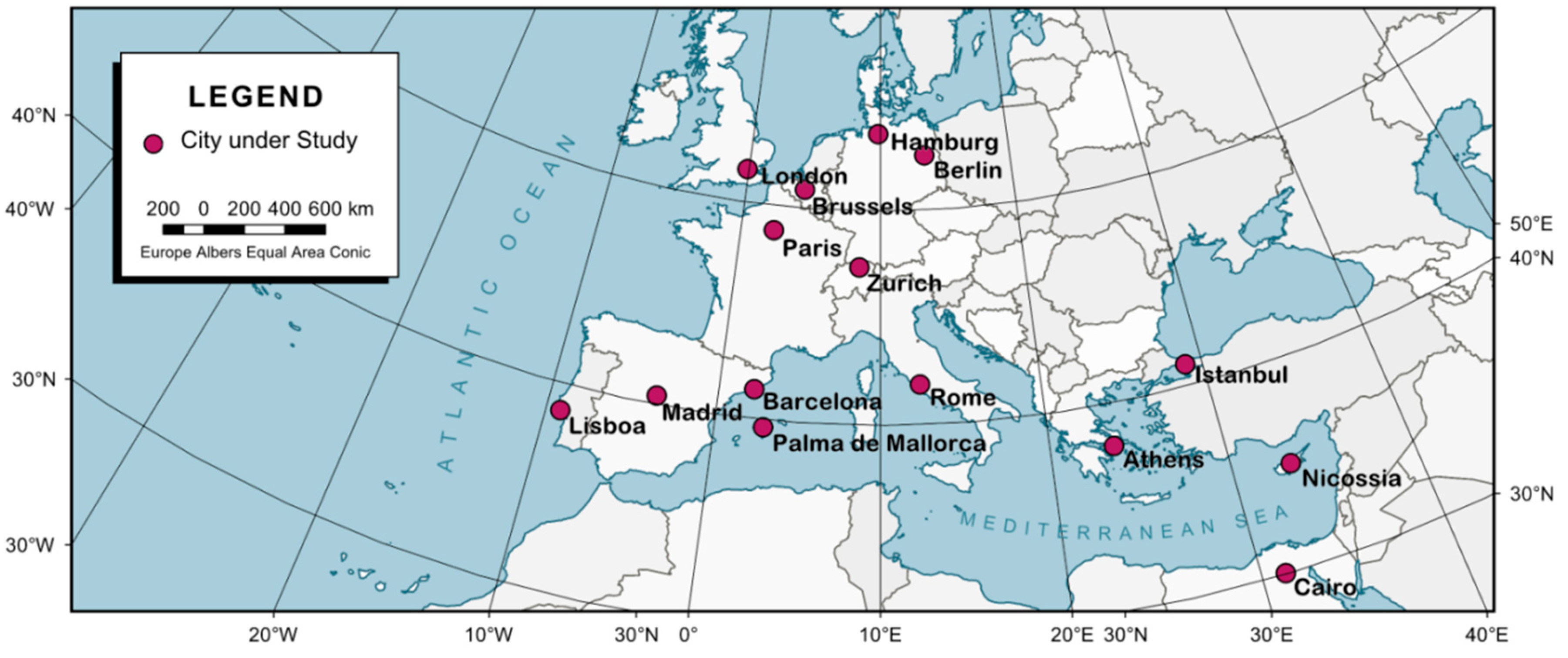
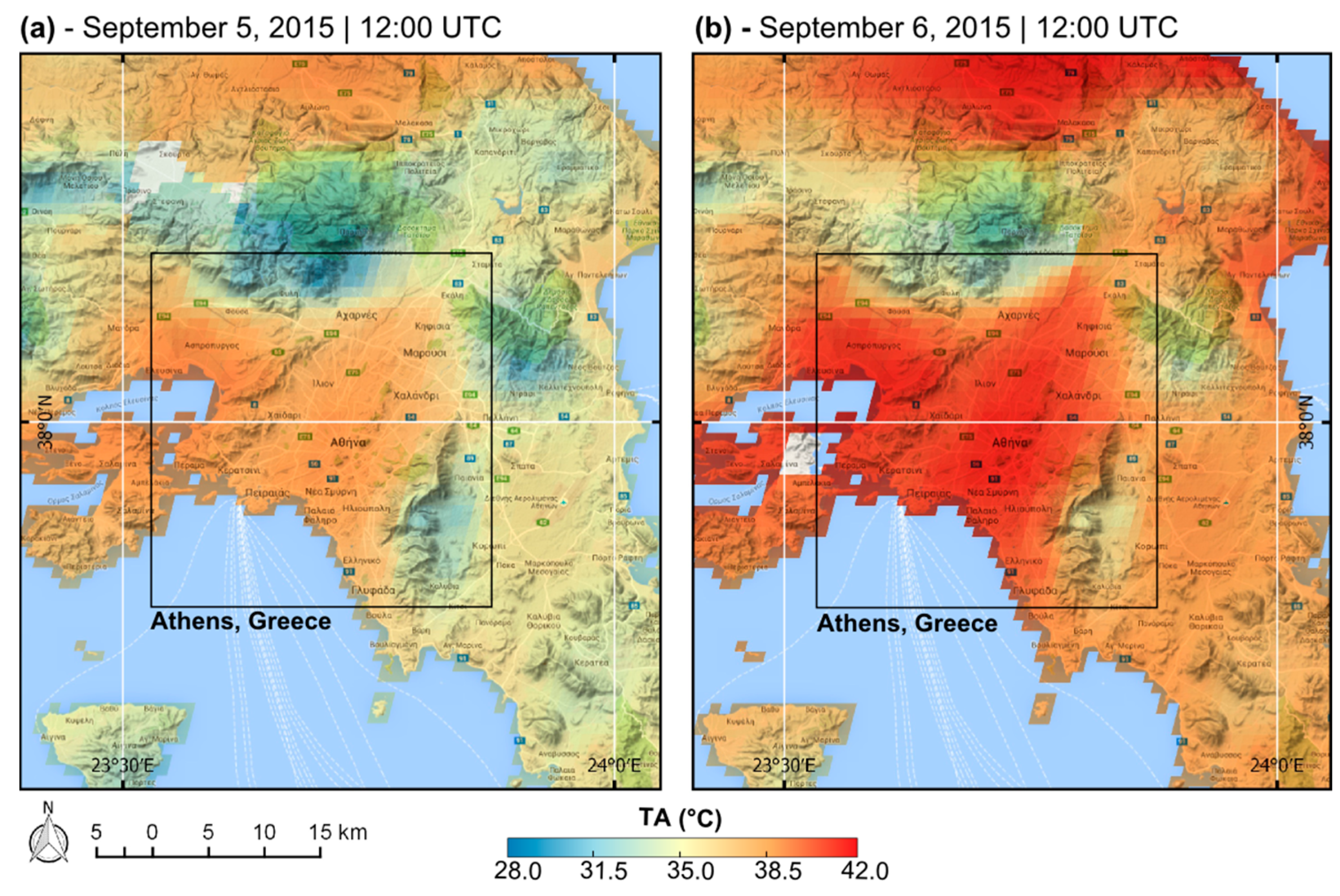
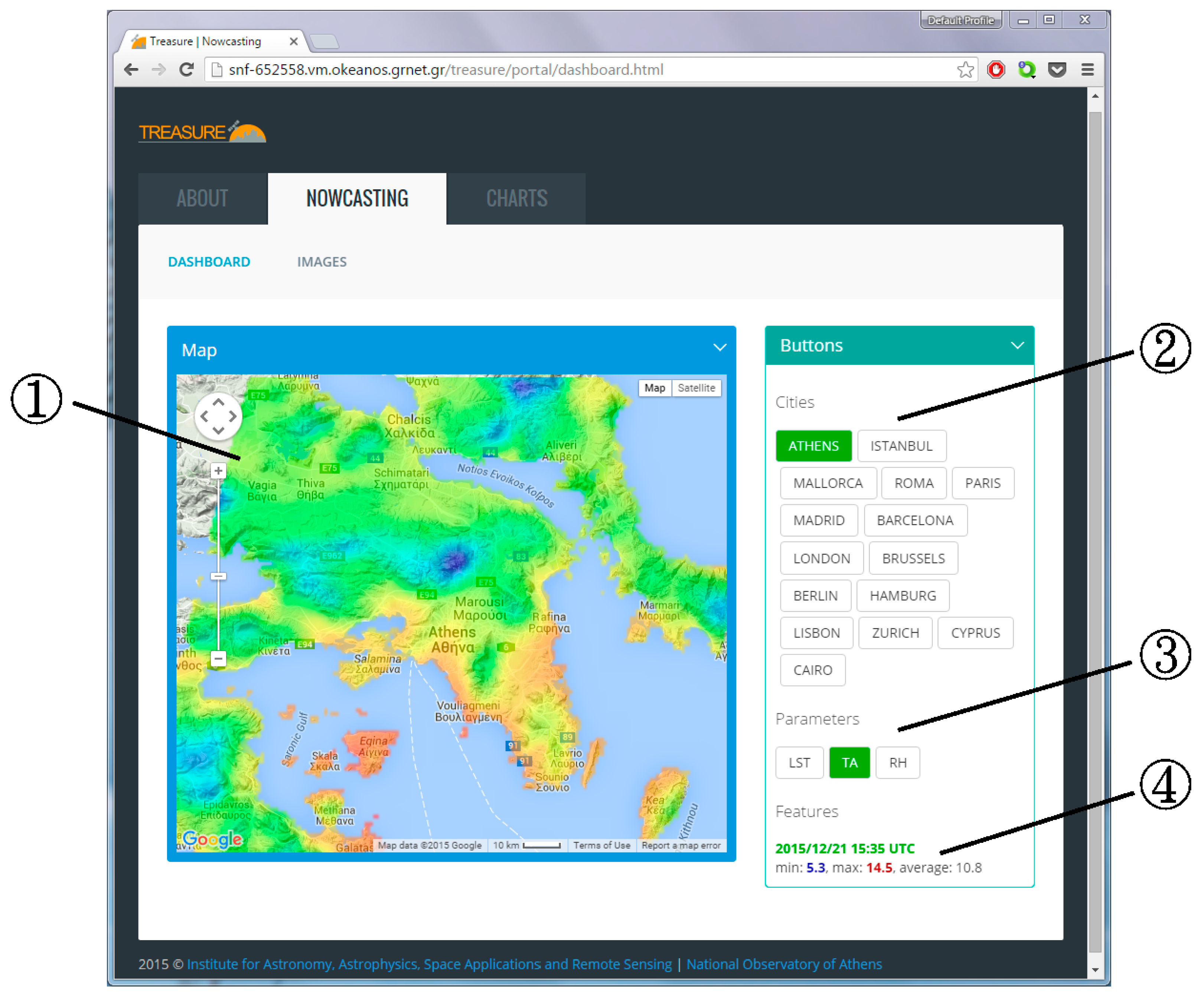
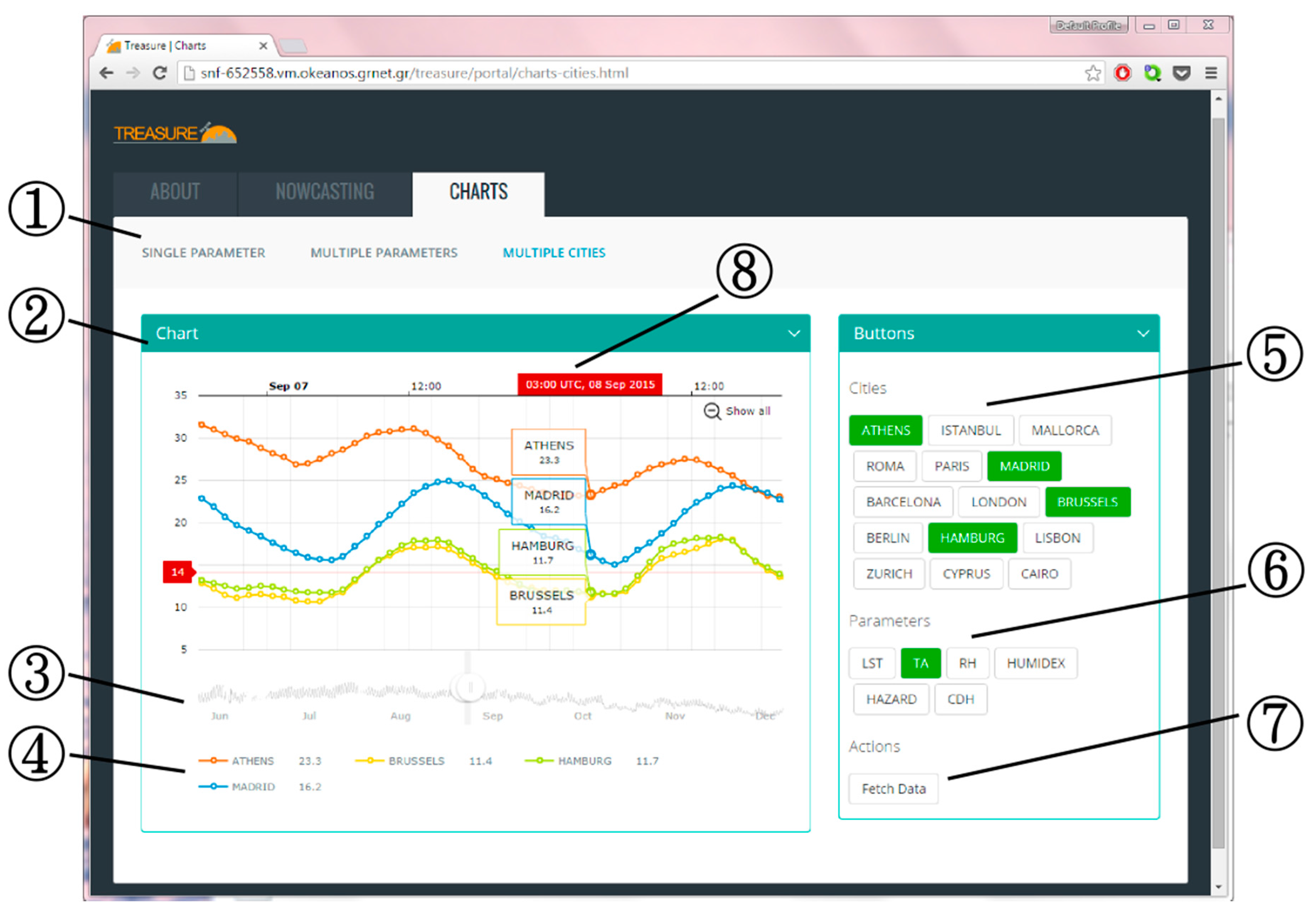
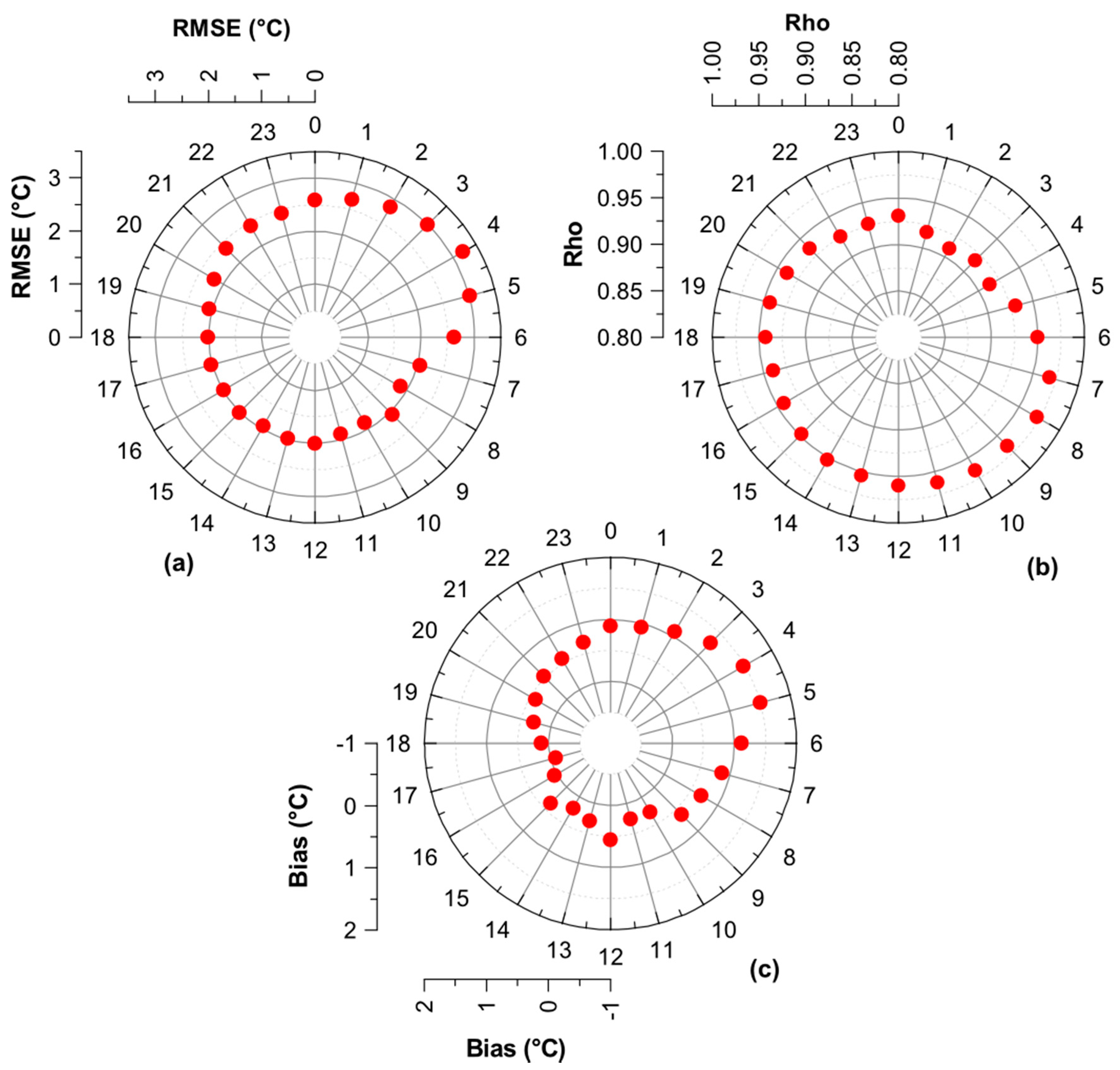
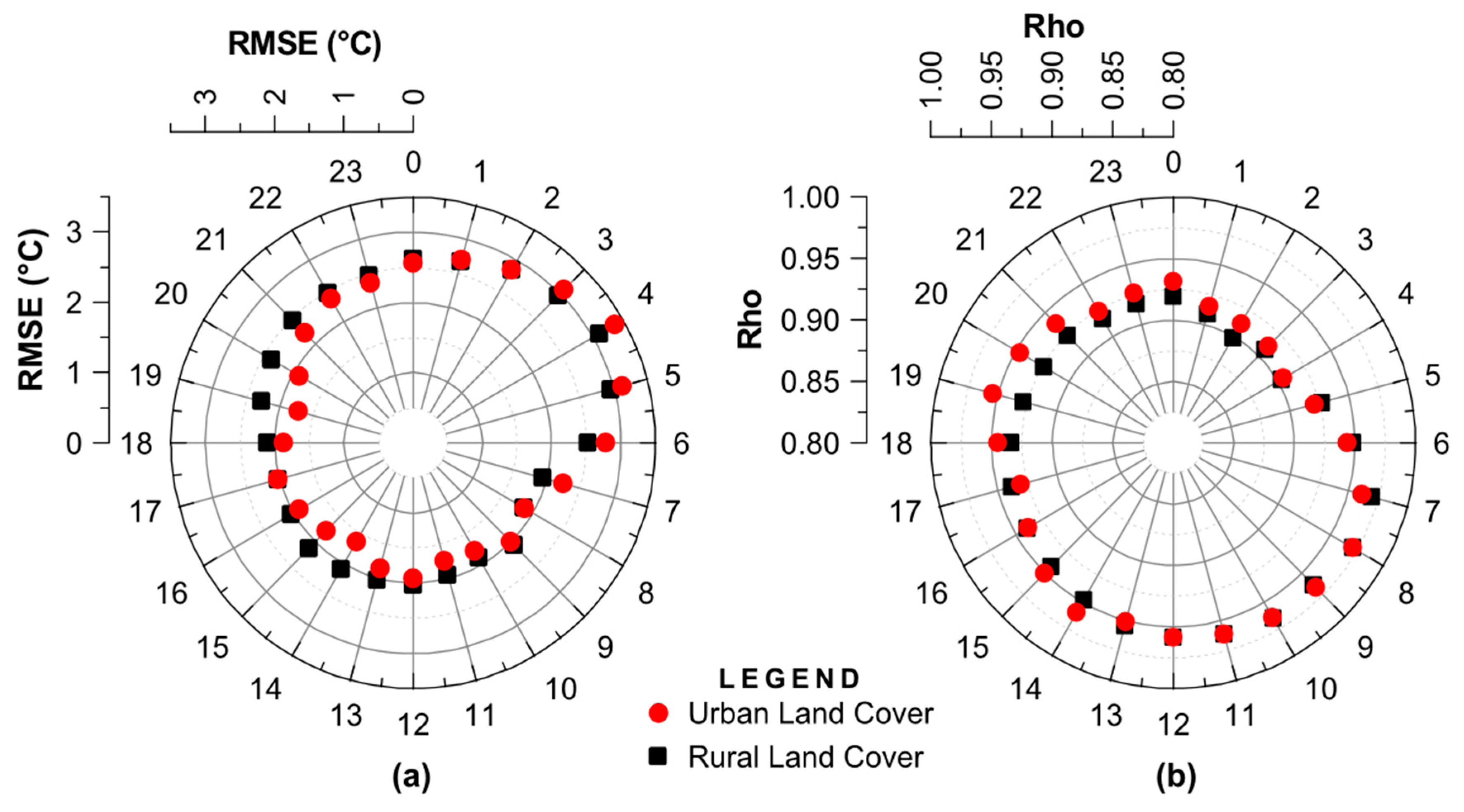

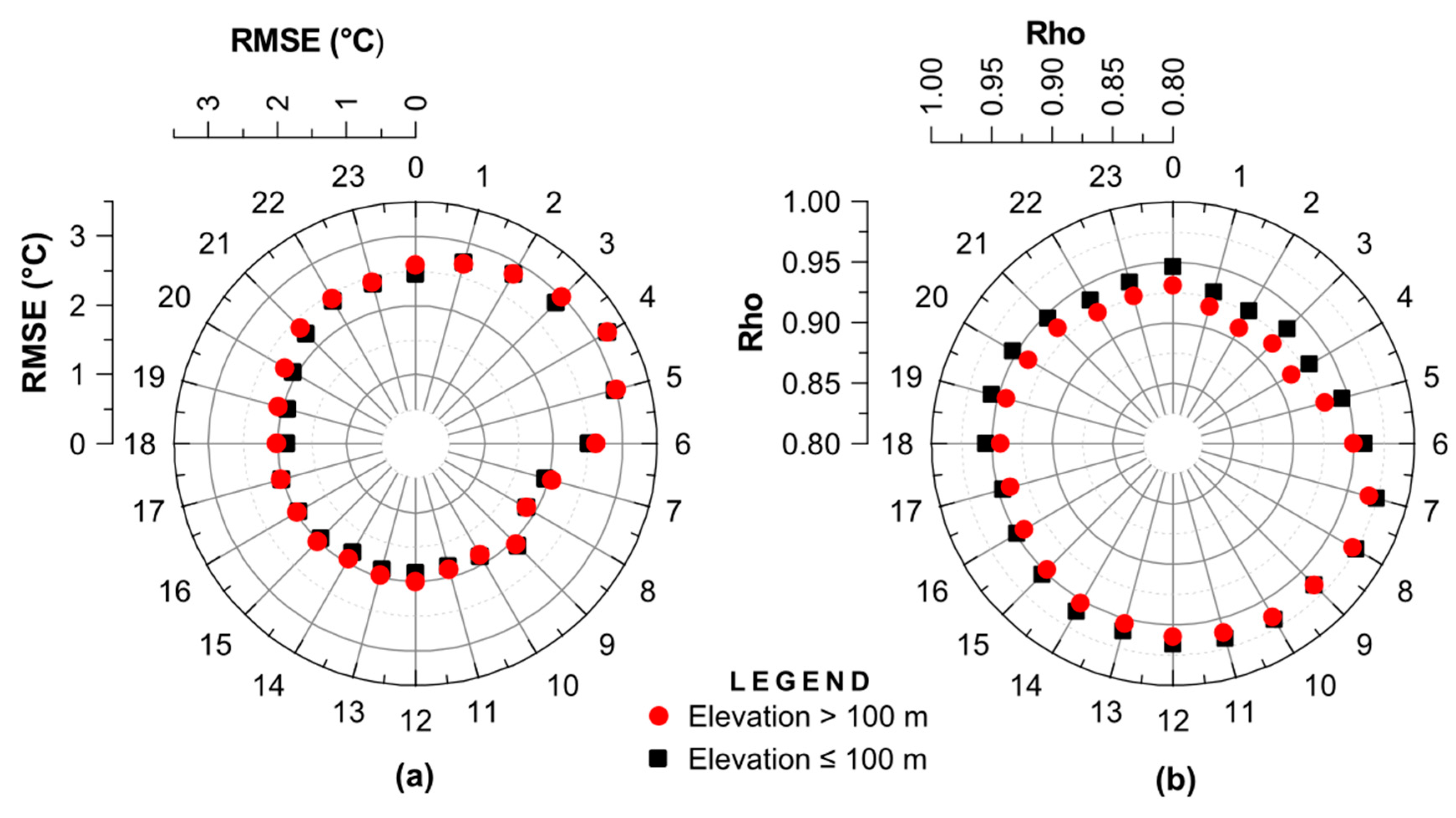
| GFS NWP Forecast Data | CMa | SPhR |
|---|---|---|
| Skin Temperature | X | X |
| Surface Pressure | - | X |
| Atmospheric Water Vapour Content | X | - |
| Temperature at various levels * | X | X |
| Humidity at various levels * | - | X |
| NWP altitude model | X | - |
| NWP landsea | X | - |
| Geopotential at surface | X | - |
| Study Area | RMSE (°C) | Rho | Study Area | RMSE (°C) | Rho |
|---|---|---|---|---|---|
| Athens | 2.2 | 0.90 | Lisbon | 1.6 | 0.91 |
| Barcelona | 1.9 | 0.87 | London | 1.7 | 0.86 |
| Berlin | 1.7 | 0.92 | Madrid | 2.6 | 0.91 |
| Brussels | 1.4 | 0.90 | Mallorca * | 2.2 | 0.89 |
| Cairo | 2.1 | 0.94 | Paris | 2.3 | 0.78 |
| Cyprus * | 3.0 | 0.82 | Rome | 2.5 | 0.91 |
| Hamburg | 1.6 | 0.84 | Zurich | 3.1 | 0.79 |
| Istanbul | 2.1 | 0.83 | Total | 2.3 | 0.95 |
© 2016 by the authors; licensee MDPI, Basel, Switzerland. This article is an open access article distributed under the terms and conditions of the Creative Commons by Attribution (CC-BY) license (http://creativecommons.org/licenses/by/4.0/).
Share and Cite
Keramitsoglou, I.; Kiranoudis, C.T.; Sismanidis, P.; Zakšek, K. An Online System for Nowcasting Satellite Derived Temperatures for Urban Areas. Remote Sens. 2016, 8, 306. https://doi.org/10.3390/rs8040306
Keramitsoglou I, Kiranoudis CT, Sismanidis P, Zakšek K. An Online System for Nowcasting Satellite Derived Temperatures for Urban Areas. Remote Sensing. 2016; 8(4):306. https://doi.org/10.3390/rs8040306
Chicago/Turabian StyleKeramitsoglou, Iphigenia, Chris T. Kiranoudis, Panagiotis Sismanidis, and Klemen Zakšek. 2016. "An Online System for Nowcasting Satellite Derived Temperatures for Urban Areas" Remote Sensing 8, no. 4: 306. https://doi.org/10.3390/rs8040306
APA StyleKeramitsoglou, I., Kiranoudis, C. T., Sismanidis, P., & Zakšek, K. (2016). An Online System for Nowcasting Satellite Derived Temperatures for Urban Areas. Remote Sensing, 8(4), 306. https://doi.org/10.3390/rs8040306





